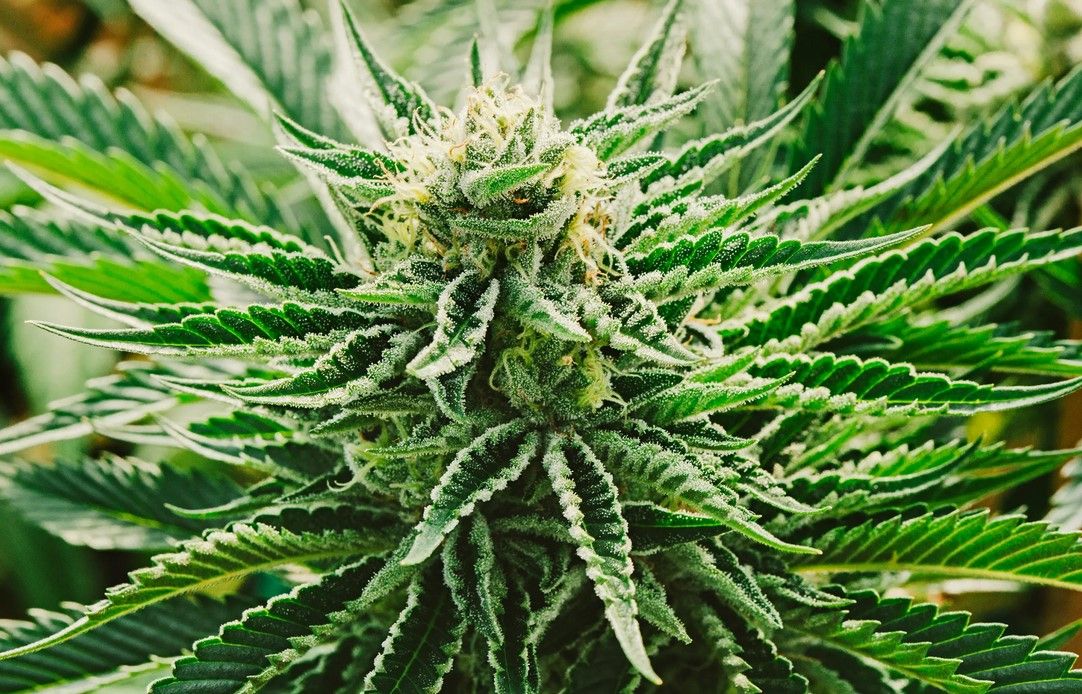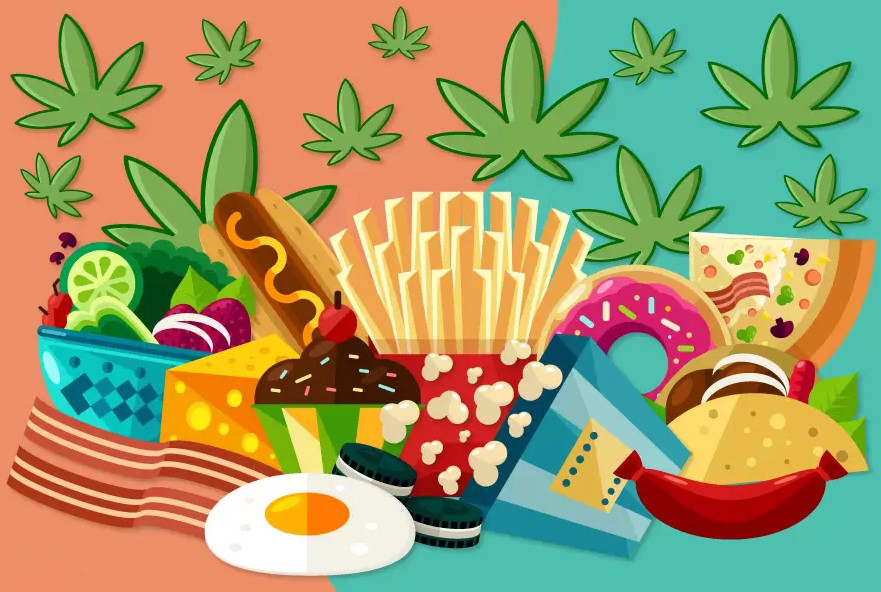Did you know that marijuana and food actually go hand-in-hand? Come and explore how our bodies react to the munchies!
The term “munchies” is so well-known that it is used by those who don’t even consume cannabis. The slang simply refers to the hunger we feel after consuming the herb or its derivatives. But do you know anything else about this feeling other than that it makes us want to eat weird combinations of foods and an entire tub of ice cream? It is already an accepted and widespread fact that ganja increases appetite, but why? The answer lies in science and our body, full of mysteries that fascinate us so much!
The munchies are commonly caused by our endocannabinoid system, which is a neuromodulator created by our bodies. This system releases substances that are similar to the cannabinoids found in cannabis plants. These let us control internal functions when something isn’t working right. Another cause of the munchies is THC, which is a cannabinoid present in cannabis plants.”
Having trouble understanding?
Let’s go!
The endocannabinoid system and the munchies
Perhaps you knew this already, but in case you didn’t – the endocannabinoid system was discovered in 1990 by Lumir Hanus and William Devane. They were both exploring the THC compound at Hebrew University in Jerusalem when they made their discovery. With further research, it was found that our bodies produce compounds similar to cannabis to help manage internal problems. Too interesting, right?
Not only does the presence of endocannabinoid receptors play a part in human physiology, but their wide distribution throughout the body explains why they are involved in regulating some of the most vital functions, such as sleep, mood, appetite, and stress. Additionally, they impact other areas such as chronic pain management and skin health.
The most prevalent endocannabinoids are Anandamide (AEA) and 2-arachidonoylglycerol (2-AG). In addition to these two, we also have endocannabinoid receptors – proteins that enable the interaction of substances with other molecules present inside it. They can be found throughout the entirety of our body and are in fact some of the most abundantly neuromodulatory receptors! The two best known ones are CB-1, found mainly in the central nervous system, as well as CB-2 which is predominantly located in both the peripheral nervous system and immune system.

Okay, but why do we feel hungry?
Our brain is a complex organ that controls everything we do. Our hunger is managed by the hypothalamus, which is a specific region in the brain. When we consume THC, it stimulates the endocannabinoid system located there. This system not only regulates our eating behavior, but also our energy balance and emotions.
The Cannabinoid type 1 receptors (CB-1) are especially responsible for this. A study with rats found that it is abundantly found in the axonal terminals of neurons. This abundance increases the pets’ olfactory capacity, making them hungrier than normal. THC also has the power to suppress your appetite suppresses, which makes you eat more but never feel satisfied.
Haven’t we heard this story before…but with mice instead?
When you’re haut, your THC levels trick your brain into thinking smells are more intense than they actually are. As a result, you experience hunger even when you’re not physically hungry.
You should never go to the market while high.
Do not make that mistake!
Other interesting facts about the munchies
When you’re high on THC, the neuroreceptor that Pleasure is increased, making food tastier and sex better. It also decreases inhibitions, which is why we love to do things stoned that we normally enjoy: like eating or sleeping. But don’t worry, it’s all scientific.
The euphoria we feel when we do things we enjoy, like eating delicious food or being with people we love, is our brain’s way of saying “thank you!”
Cannabis has medicinal benefits and can be used to help patients with eating disorders or other appetite-related problems. This little plant is very powerful and can help many people in many different ways!
How to avoid munchies?
- If you want to circumvent the lara, you can:
- Smoking after eating, to exercise your brain satiety center.
- Find things to take your mind off of food. Exercising creativity is a great way to get distracted and avoid overeating.
- Hide the goodies. A little drastic, but it can work!
- Smoking strains with less THC, like ACDC and Power Plant.
About cannabis edibles
If you plan on consuming cannabis through food, be mindful of dosage levels! People have been known to get the munchies and eat their own cooking – resulting in an overdose. To avoid this, remember to cook extra food that is marijuana free. It’s also useful to have other snacks around in case of emergency.
It’s worth remembering that consuming this plant in food is also a strategy to reduce damage. Of course, there is no process but you have to eat it right, see? Did you like learning that? One thing that seems so simple is actually quite complex – and we love it about cannabis and its relationships with our body. Do you want to know anything else? Tell us in the comments below!
Which Marijuana Strains Don’t Produce the Munchies?
The “munchies” is a popular term used to describe the phenomenon of increased appetite after consuming cannabis. While marijuana offers many benefits like stress relief, improved creativity, and social enhancement, one major downside is that it can lead to overeating and weight gain.
Being high on marijuana shouldn’t make you balloon in weight due to an insatiable hunger for sugar and fried foods. It would be great if there was a way to get the same benefits of being high without experiencing the munchies, but sadly science hasn’t found a way just yet. However, some weed strains are less likely to give you those cravings than others.
If you’re looking for a souche of marijuana that will give you the desired physical effects without making you feel nauseous, we have all the information you need.
High-CBD Strains
It’s not cannabis that gives you the munchies; it’s THC. If you have ever tried a high-CDB strain before, you might have noticed that they don’t cause the same insatiable hunger as THC-rich varieties do. A study found that THC, which is also responsible for cannabis’ euphoric effet, activates certain nerve cells in the hypothalamus – an area of the brain linked to primal instincts like hunger.
Although there is limited data on how CBD affects appetite, we do know that it has the opposite effect of THC. Some scientists have even suggested that CBD could be used as a treatment for obesity because of its influence on the brain.
Professionals recommend high-CBD, low-THC strains to minimize the risk of excessive hunger. However, a strain with equal parts THC and CBD could also reduce hunger and create mild euphoria.
High-THCV Strains
THCV is a cannabinoid that shares similarities to THC, but instead of causing hunger like THC does, this one suppresses appetite. Most strains on the market today have 10-20% THC, while those with high levels of THCV only contain about 5%.
You may have noticed that sativa strains of marijuana tend to provoke less hunger than indica strains. This is because THCV, the active ingredient in marijuana, is more abundant in sativas. In fact, scientists are considering using THCV to treat diabetes and obesity due to its unique make-up.

Marijuana Strains to Use Without Getting the Munchies
The strains of marijuana that don’t produce the munchies, based on the information above.
Moby Dick
The Moby Dick strain might taste sweet and citrusy, but it won’t make you as hungry as other strains will. If you are looking for an energetic strain to help keep your day moving, look no further –Mobydick is known for being just that! Its high THCV content is what prevents it from causing intense cases of the munchies.
The Moby Dick high is lighter than most, making the user more alert and putting them in a positive mood. It’s a great strain for new smokers and especially those who don’t want to overdo it with their snacking.
Blue Dream
Authentic Blue Dream is hard to find these days. But if you are lucky enough to encounter some, it would be wise to buy in bulk. It’s a favorite pre-workout for many pot smokers and athletes because it doesn’t make you crave snacks afterward. The only catch is that you have to verify that it’s the real thing before making your purchase.
Blue Dream is a top strain in California for its ability to provide mental stimulation and full-body relaxation. It’s commonly used by those who struggle with depression, pain, or other conditions.
Canna-Tsu
The cannabis strain known as Canna-Tsu is rapidly gaining popularity in the United States, currently being sold in Illinois, California, Oregon, Colorado, Washington, and many other medical marijuana states. Earthy and sweet to the taste buds yet providing a clearheaded high that can improve focus and mood makes this strain a favorite among users. Additionally though it’s effective at calming an upset stomach Location:New York
It shouldn’t lead to surges of hunger/the munchies.
Remedy
Remedy, an indica cross between Afghan Skunk and Cannatonic, is the ideal solution for those with an insatiable appetite. With a THC level that rarely gets past 1%, this strain provides physical relief and mental tranquility without the psychoactive effects. Remedy is perfect for patients looking to curb anxiety, headaches, tension, pain or insomnia but don’t want their day interrupted by regular snack breaks.
Jack Herer
Jack Herer contains THCV and is known to be less likely to cause hunger than regular THC – while also being less potent. This makes Jack Herer worth investigating for anyone looking to reduce how much they snack. But regardless of its unique uses, it’s an easy smoke that is perfect for relaxation at the end of a tiring day.
Poison de Durban
Durban Poison, with an average THCV content of 0.2% to 1.8%, is a great tool for managing overactive appetites and can be found in many large markets. Its upbeat, active high that can spur productivity is cherished by users, and this pure sativa originating from South Africa will help you focus on what matters rather than giving into cravings for snacks.
Red Congolese
Red Congolese is a deeply energetic strain that comes from Africa. It is more likely to give you energy and motivation than make you want to eat everything in sight. This strain focuses all of its psychoactive energy in the head, which helps focus and creativity to thrive. Among the list of physical activities that Red Congolese motivates, you will sooner find hiking more appealing than eating the entire contents of your fridge.
Final Thought
Don’t bank on cannabis to lose weight even if it restrains your appetite. Instead, aim to lead a healthier lifestyle by working out for 30 minutes every day and eating healthy meals. If you want to ease any post-workout pain while following this routine, consume an appetite-suppressing strain of cannabis.

